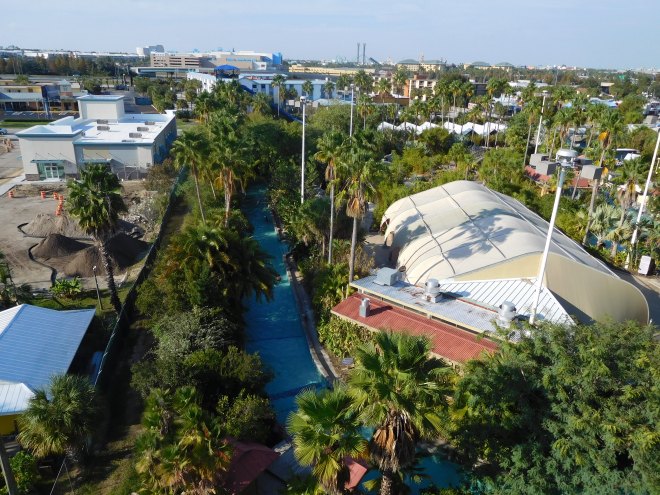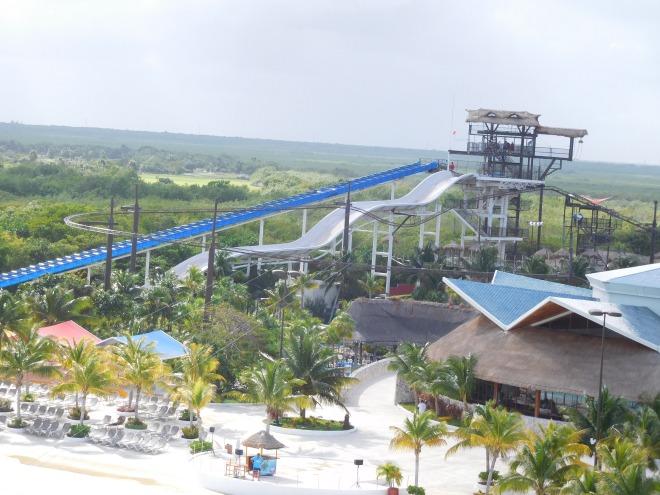In this article, we will talk about the debut of the water park as we know it and talk about the various innovators. River Country, Wet’ n Wild, KECO and others are featured in this article.
Walt Disney World opened in 1975 a unique attraction patterned after an “old-fashioned swimming hole.” River Country was located off Fort Wilderness Campground and used a section of Bay Lake walled off, and it’s own self-contained water system that drew water from Bay Lake. It was a unique park, but it concentrated more on the swimming aspect, and the few water slides were mostly very basic body slides. The standout attraction was the “White Water Rapids,” a 330 feet long river that flowed downhill down chutes, through a waterfall and past bubbling rapids. Guests initially rode in black inflatable tubes that were clearly inspired by rubber tires and that type of river attraction did encourage George Millay and many water park operators.
What we now know as a water park is Wet’n Wild, and that concept created by George Millay, an industry legend who was also the driving force behind SeaWorld. After opening SeaWorld in Orlando in 1973 and being subsequently removed from his own company, George Millay saw a compelling need in the summer when he realized how hot and humid it was at that SeaWorld location. Now, adding a log flume (which was the only high capacity water ride available at the time) could have been a fix and already being done by parks, but he thought outside the box and looked at trends around the world. For example, Ontario Place in Toronto, ON had an attractive splash pad feature designed by famed designer Eric McMillan and various places around the world opened large pools that generated waves. So he leased a great piece of land further north on International Drive and found partners who helped him gather the funds to build a unique park: the focus would not be on animals or a roller coaster, and instead, the main draw would be a huge wave pool and Splash Pad.

Universal Studios Orlando was kind enough to go through their archives and provided us with this great picture of the park when it opened. Please visit their page and support their new water park, Volcano Bay. Volcano Bay official page

The Wave Pool.
A large wave pool with a giant deck centrally constructed, and an early pair of Freefall slides called the Kamikaze constructed near it. He also had the chance to visit River Country and after riding White Water Rapids, decided to bring that type of River to his park, and he opened it on a hill he constructed at the Northwest point of his property. The attraction still run today amazingly and was transformed in 2003 into “The Blast.” The theme to that makeover was a tour of a water factory where everything was blowing up.

The entrance to The Blast.

A look at the end of The Blast on the left.

One of the water feature added when The Blast was reimagined in 2003.
White Water Slideways was the other in the ground slide on that hill and replaced in 1986 by a tall tower and five new slides from WhiteWater West Industries. 3 of those used foam mats and riders slide face first through the spiraling course, and the other two were traditional body slides. Interestingly, both the Raging Rivers and White Water Slideways were constructed with Gunite, what is known today as Shotcrete. George Millay at the time was not happy with what could be done with fiberglass since the existing molds were so limited.

A look at the 3 Mach 5 slides that remained.
In 1994, the park retired the two enclosed body slide from Mach 5 and replaced them in 1996 with two new Pipeline from Proslide Technologies called at the time the Fuji Flyer. What still makes “The Flyer” (as the Fuji sponsorship has now lapsed) unique is that it is the only Proslide Pipeline to use large four passenger inline rafts for maximum capacity.

The post sponsorship sign for The Flyer.

The large rafts used on The Flyer.
In 1979, George Millay had the prototype “Kamikaze” constructed at his park. Located to the right of the main entrance and wave pool, the 60 feet tall tower would have two slides where riders would go down a double dip before arriving in a pool at the bottom. Each slide was 300 feet long and was twice as tall as any other slide in operation in the US. It was a major headliner that gave the park a landmark that could be seen from far and is credited with increasing attendance by 25% at the park. Those double dipping Kamikaze slides were retired in 1991 and replaced by Bubba’s Tub, a Five Person family raft slide that features a triple dip motion.

Our friend Flex visited the park in 2009 and he was kind enough to provide us with this great picture of Bubba Tub. As you can see, it featured a very compact raft conveyor to take the giant tubes back to the top.

In 2014, Wet’ n Wild replaced Bubba Tub by the Aqua Drag Racer, a four lane KrakenRACER from Proslide.

The underside of Aqua Drag Racer. Notice how Proslide managed the impossible and managed to fit all 4 flumes in the same space as the previous attraction.
George Millay visited a recreation area in the Jaya Ancol region of Indonesia. There, he saw guests having fun and walking around in a large moat-like river that circled an island. The river was 1700 feet long, but at the time, that river filtration system broke, and this was a huge challenge when he brought the idea back to Wet’n Wild. Those issues were solved when water jets were installed 100 feet or so to keep the water circulating, and the river itself was 12 to 15 feet wide with 3 to 4 feet deep of water. Over at Wet’n Wild, guests can either float on a tube or walk along the river. Mr. Millay had trademarked the term “Lazy River,” but the number of parks using the name got so large it was impossible to keep up. It eventually became the generic name for that attraction.

The Lazy River.

Notice the large tent constructed on the Lazy River island on the right.
Interestingly, the Lazy River has an island that had various vocations throughout the year and currently, a pavilion hosts an All-You-Can-Eat buffet called the Riverside BBQ and Cabanas that can be rented by guests. This demonstrated that Lazy Rivers are incredibly efficient attractions both from a capacity point of view and land use. Given how small water parks usually are, this is extremely important and was the launching point for various other types of rivers.

The Black Hole opened in 1990, replacing the original Corkscrew slides. Like the Lazy River, this was also copied by various parks around the world.

Brain Wash opened in 2007 and replaced the Blue Niagara braided slides and the Hydra Fighter swinging attraction. Originally, it did not have a raft conveyor and this made it quite challenging for guests to bring the large rafts to the top!
The same tower is also used for Der Stuka, a steep body slide.

Der Stuka is on the right.

The unique spiraling walkway for the Der Stuka/Brain Wash tower.

Blastaway Beach opened in 2012 and was the last Children’s Area to be installed at the park.

This Proslide RideHouse featured a unique water dropping system.
Over in Texas at the then planned Wet n Wild Arlington park, Wet’n Wild opened in 1983 with the Lazy River forming a moat around the Surf Rider wave pool. That became the blueprint for the four others Wet’n Wild parks that opened after and this model followed by many water park designers.

Wet’ n Wild Cancun was rebranded as “Ventura Park” a few years ago and along with the name change, the concept changed. Dry attractions along with ziplines and extreme attractions were introduced. The entry ticket also include food and drinks and it is sold as an “all-inclusive day”.

Most aspects from the original Wet’ n Wild remain such as the Lazy River with an island.

Bubba Tub is still the featured slide at the park.

Bubba Tub. Notice the very wide flume used by Proslide on that type of Mammoth family raft slide.

The main slide tower at Ventura Park feature two Multi-Bump and two Pipeline slides from Proslide.

To save space, the arrivals of both pair of attractions are stacked on top of each others.

Judging by the signature George Millay sphere, we can presume this was another attraction at some time. It was replaced by two bowl slides that we were unable to determine the supplier.
The Wave Pool is usually the main draw, and strategic placement will help the water park evolve and grow. In the 1980’s and early 1990’s, when theme parks expanded with water park additions, many tried to copy what was done at their main park directly. They would either build a tiny wave pool or simply forgo one in other to create a lot more slides and maybe a Lazy River would be included. This approach was seen at KECO (now owned by Cedar Fair) parks and early Cedar Fair water parks and met with a mixed response: turns out that guest enjoys wave pools and it was a glaring omission that had to be corrected. But, what do you do when your waterpark is fully built out, or you are so landlocked you can’t spare the vast space? Over at Valleyfair (Shakopee, MN), the park log flume had to be removed, and the land leveled so that a wave pool and other facilities could be constructed.
